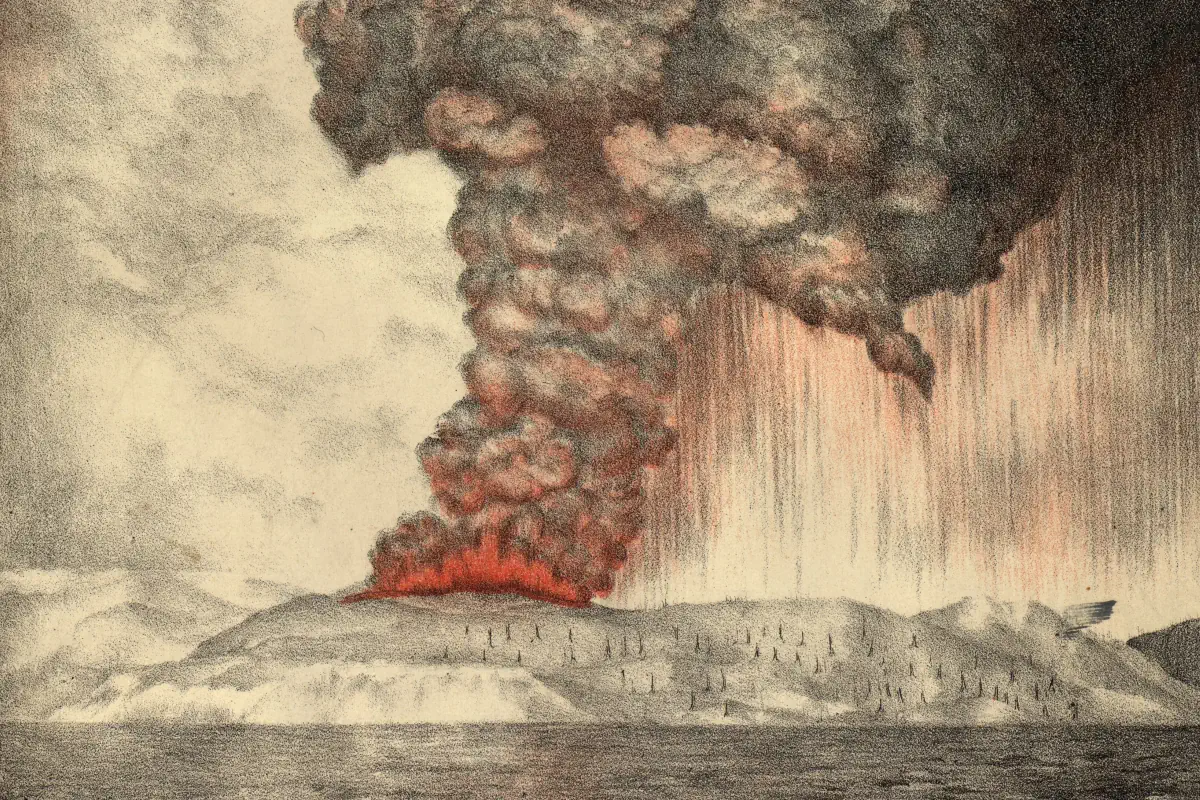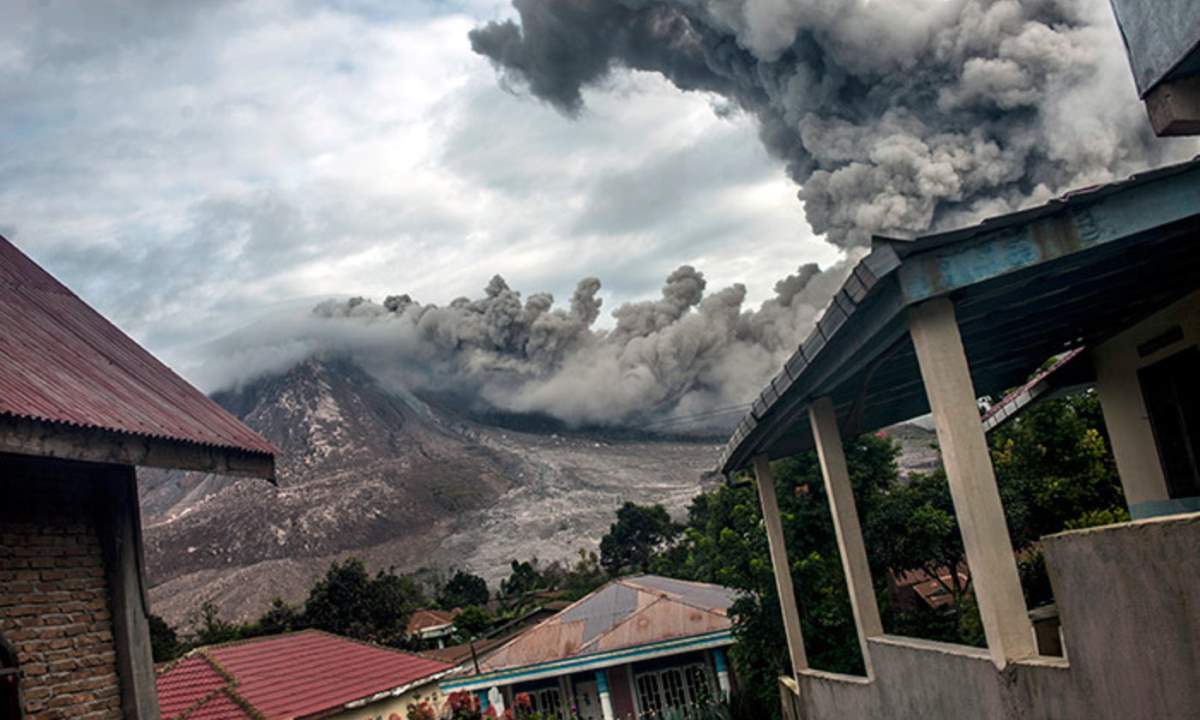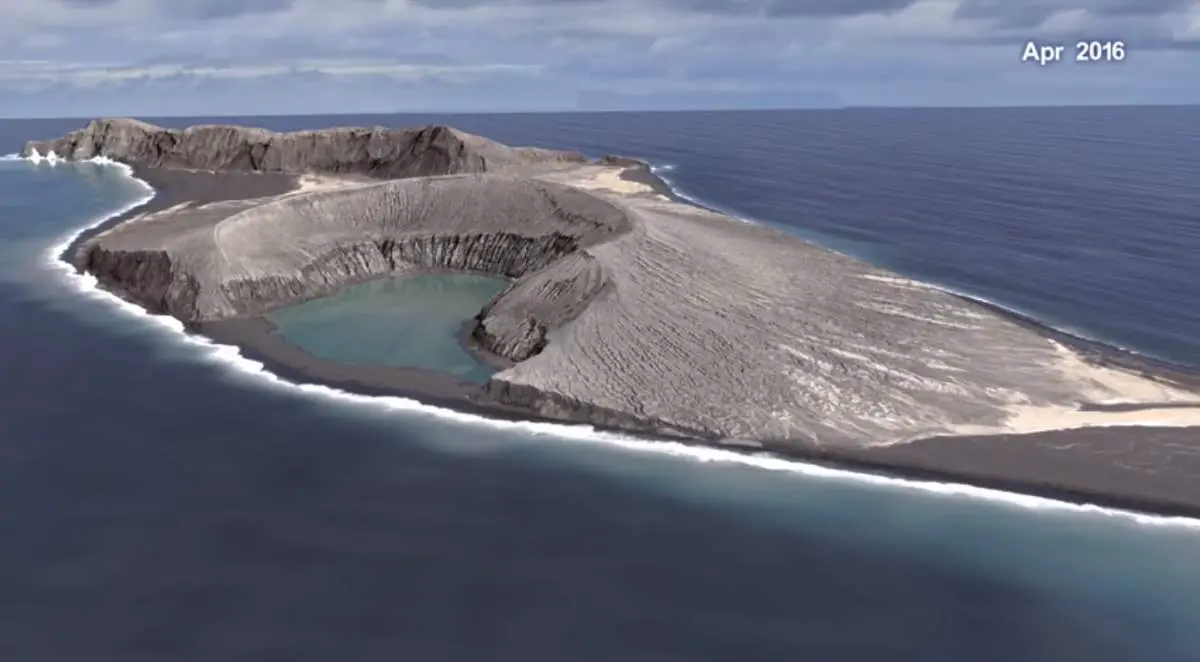On August 26-27, 1883, one of the most notorious volcanic eruptions in history occurred. Krakatau (often spelled Krakatoa) erupted with an estimated 10,000 thousand times the force of the Hiroshima atomic bomb. The eruption was so violent that two-thirds of the island of Krakatoa and its surrounding archipelago were destroyed: about 23 square kilometers of Earth sank into the Sunda Strait.
Across Java and Sumatra, burning rock rained down, damaging and even destroying settlements. The sky went black.
Here are 10 amazing facts about the 1883 eruption of Krakatoa.
1. 1883 eruption of Krakatoa produced the loudest noise on human record
The explosions heard in the 1883 eruption remain the loudest noise on human record. The sound was heard across the Indian Ocean, as far away as Rodriguez Island, 4,653 kilometers (2,891 miles) to the west, and Australia, 3,450 kilometers (2,144 miles) to the east. The sound of the eruption was so loud it was reported that if anyone was within 16 kilometers (10 miles) from the center of the explosion, they would have gone deaf.
The estimated sound level of the explosion was 310 dB, loud enough to be heard 5,000 kilometers (3,100 miles) away. The sound ruptured sailors’ eardrums 64 km (40 miles) away on ships in the Sunda Strait.
As late as one year after the eruption, human skeletons of tsunami victims were still washing up on the coast of Africa.
2. Krakatoa gave early warnings before the eruption
Even years before the 1883 eruption, seismic activity around the Krakatoa volcano was intense. There were many earthquakes with some of them felt as far away as Australia which is 3,690 kilometers (2,293 miles) away.
In May 1883, a sudden rumbling started out of nowhere. There was also a faint tremor.
Beginning on 19 May 1883, steam venting began to occur regularly from Perboewatan, the northernmost of the Krakatoa island’s three cones (the others being Danan and Rakata). Eruptions of volcanic ash reached an estimated altitude of 6 kilometers (20,000 feet) and explosions could be heard in New Batavia (Jakarta) 160 kilometers (99 miles) away.
Scientists launched expeditions on private boats to take a closer look. In early August, just weeks before the destructive explosion, in early August, Captain H. J. G. Ferzenaar, a Dutch topographical engineer, investigated the Krakatoa islands. He noticed that:
- three major ash columns and steam plumes from at least eleven other vents
- an ash layer about 0.5 meters (1 ft 8 in) thick
- the destruction of all vegetation, leaving only tree stumps
Ferzenaar (rightfully) felt that the place was very dangerous and advised against any further landings.
By 25 August, the eruptions intensified. On 26 August, a black cloud of ash could be seen 27 kilometers (90,000 feet) high.
Finally, on On 27 August, four enormous explosions, each bigger than the last, which marked the terrifying climax of the eruption occurred.
During its final cataclysmic eruption, Krakatau, which had been an island of about 30 square kilometers (12 square miles), nearly vanished. A total of 25 cubic kilometers (6 cubic miles) of material, including both new magma and bits of the old island, were blown into the stratosphere, the eruption column reaching more than 30 kilometers (20 miles) high.
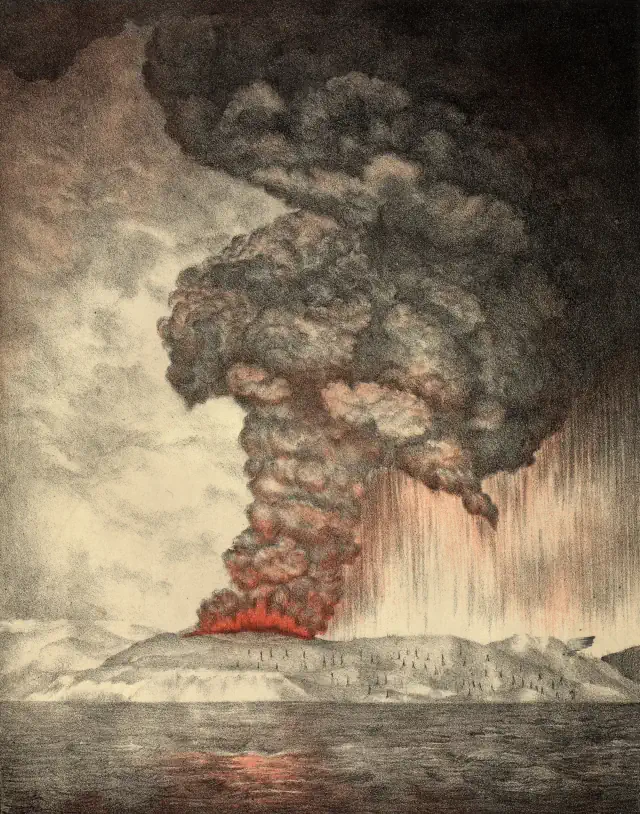
3. Pyroclastic flow killed about 4,500 people
After the explosion, a pyroclastic flow (a very fast-moving current of hot gas and volcanic matter) swept along the island at 150 km/h (93 mph). It obliterated nearby islands and killed an estimated 4,500 people.
4. The explosion also produced huge tsunamis that killed more than 30,000 people
As explained above, about 23 square kilometers of Earth sank into the Sunda Strait because of the huge explosions, displacing billions of tonnes of seawater.
This generated a series of tsunamis, which produced waves as high as 37 meters (120 feet) tall, capable of destroying anything on their path.
In fact, the real killer was these waves: the huge tsunamis created after the eruption were responsible for most of the 36,000 deaths associated with the 1883 eruption of Krakatoa.
5. The sky darkened up to 442 km (275 miles) from the volcano
The explosions sent an estimated 45 km3 (11 cubic miles) of volcanic ash and debris into the atmosphere, darkening skies up to 275 miles (442 km) up to 442 km (275 miles) from the volcano. In the immediate vicinity of Krakatoa, the sun did not be seen for about three days.
6. The explosion caused a global cooling
The explosion sent so much volcanic ash into the atmosphere that it filtered the amount of sunlight reaching Earth’s surface. As a result, global temperatures would fell 0.4 °C (0.72 °F) the next year.
Temperatures went back to normal again in 1888.
7. Krakatoa’s atmospheric effects felt worldwide even months after the explosion
In New York, the sunsets of 1883 November were such a fiery red that people thought a huge fire had broken out.
In England, poet Gerard Manley Hopkins (28 July 1844 – 8 June 1889) wrote of clods that shimmered green, purple, and gold in the evenings.
One November evening that year, then 19 years old Edvard Munch (12 December 1863 – 23 January 1944, famous Norwegian painter) was walking with his two friends in Oslo. He noticed an amazing and extraordinary sunset. He later wrote “all at once the sky became blood red-and I felt overcome with melancholy. I stood still and leaned against the railing, dead tired. Clouds like blood and tongues of fire hung above the blue-black fjord and the city. My friends went on, and I stood alone, trembling with anxiety. I felt a great, unending scream piercing through nature.”
Munch never forgot that sky, and during his lifetime he wrote many such accounts of this memorable evening.
Ten years later, he created the first version of his most famous painting: The Scream. It was in four versions: two pastels (1893 and 1895) and two paintings (1893 and 1910). The reddish sky in the background of the painting is Munch’s memory of the effects of the powerful volcanic eruption of Krakatoa.
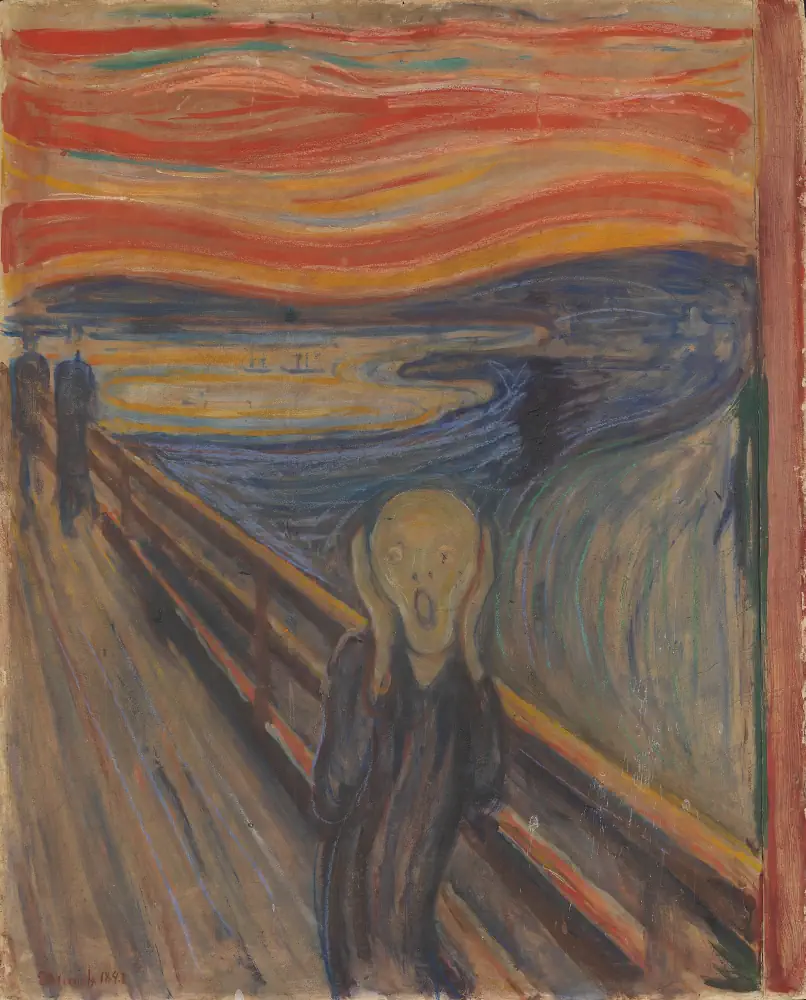
8. Before the 1883 explosion, Krakatoa was sleeping for more than 200 years
The only confirmed eruption prior to 1883 was in 1680. It was a moderate one.
9. Krakatoa was the first modern disaster
The 1883 eruption of Krakatoa was the first modern disaster: it captured the world’s attention and it would set the template for disaster reporting which even today most journalists copy from.
In fact, the 1815 eruption of Mount Tambora was bigger and far deadlier, but it went almost unnoticed due to the lack of global communications at the time. The first undersea telegraph cable, for example, laid between England and France 35 years after the 1815 Mount Tambora eruption.
10. There’s a new volcano today: The Child of Krakatoa
In 1927, About 50 years after Krakatau destroyed itself, a new island appeared from the sea in about the same place. Called Anak Krakatau, meaning “Child of Krakatau” (or the child of Krakatoa) this young volcano now stands about 500 meters (1,500 feet) above the waves.
Since then, Anak Krakatau has been the site of frequent eruptions. This image of Anak Krakatau was taken by the Ikonos satellite on June 11, 2005. The volcano has been the site of frequent eruptions since 1927.
While satellite imagery of Krakatau’s 1883 eruption is obviously not available, we do have images of Anak Krakatau to share (see the image below). “Anak Krakatau”, meaning “Child of Krakatau”, is an active volcano located in Indonesia in the Pacific Ocean.
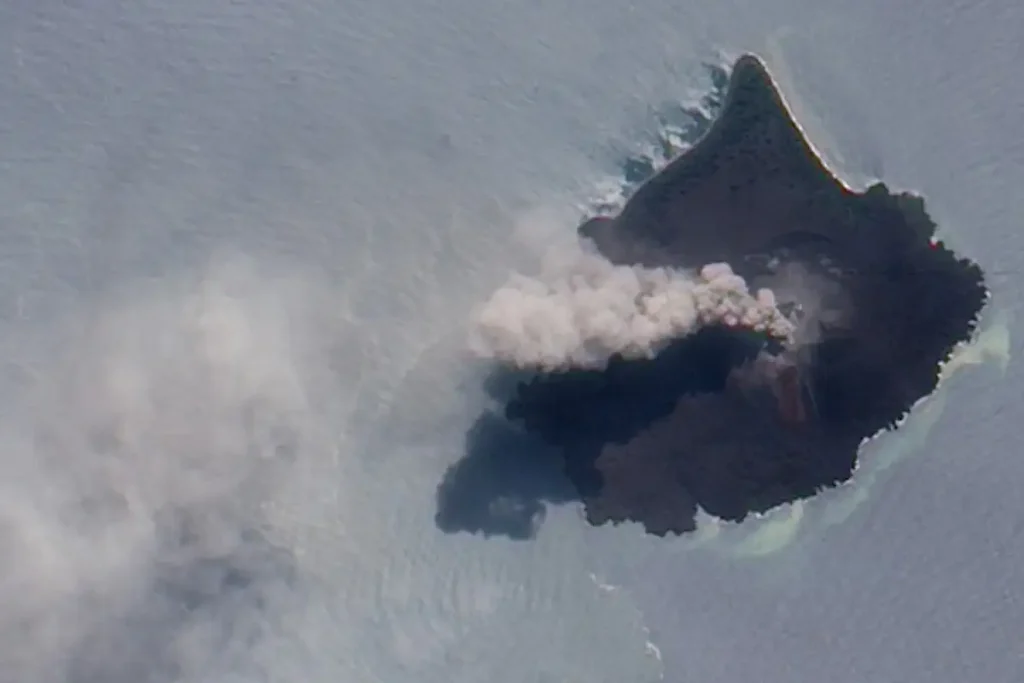
Like most of the approximately 130 active volcanoes in Indonesia, Krakatau was formed along the Sunda Arc, a 3,000-kilometer long (1,864 miles) curve where the Australia Plate sinks beneath the Eurasia Plate. Where these two sections of the Earth’s crust meet, earthquakes and volcanic eruptions are common. Krakatau and the Sunda Strait sit at the hinge of the curve between Sumatra and Java, making this a region particularly prone to geologic activity.
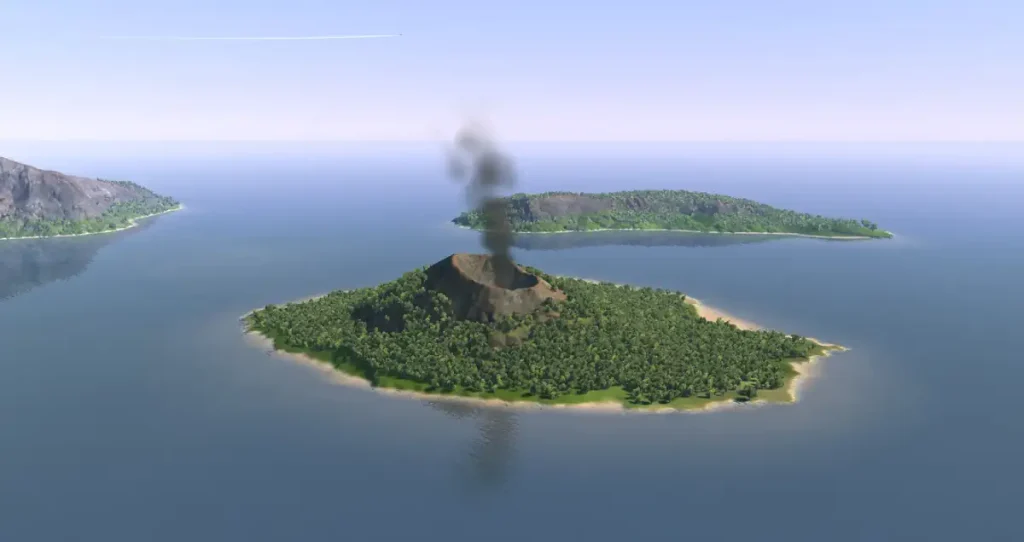
Sources
- Krakatoa on Wikipedia
- 1883 eruption of Krakatoa on Wikipedia
- Moon Landings: All-Time List [1966-2025] - February 2, 2025
- What Is Max-Q and Why Is It Important During Rocket Launches? - January 16, 2025
- Top 10 Tallest Rockets Ever Launched [2025 Update] - January 16, 2025
